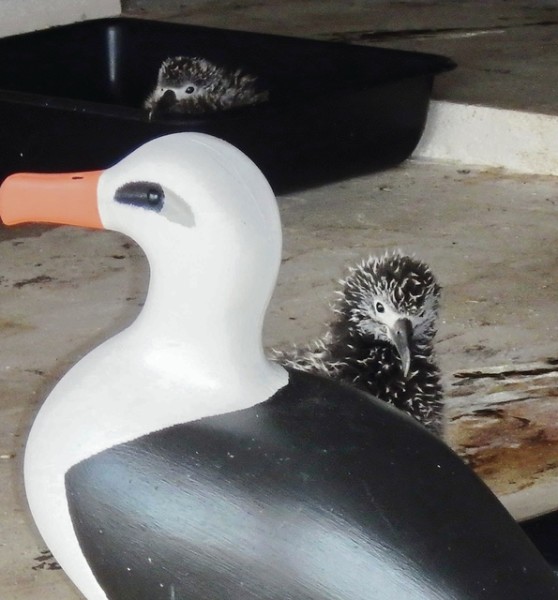Published in the Ocean Watch column, Honolulu Star-Advertiser © Susan Scott
March 28, 2016
Last week I visited the cutest albatross chicks in the world, balls of down so bottom-heavy they look like beanbag toys.
OK, all baby birds are adorable, but these aren’t your average chicks. They’re subjects in a grand experiment to start a new albatross colony in a protected place.
This story begins in the 1970s when albatrosses began laying eggs at the Navy’s Pacific Missile Range Facility on Kauai’s west coast. Besides the big seabirds being aircraft hazards, dogs destroyed their eggs and killed their chicks.
 These albatross chicks, with an adult decoy, were raised at
These albatross chicks, with an adult decoy, were raised at
James Campbell National Wildlife Refuge in Kahuku.
©2016 Susan Scott
Workers tried shooing the birds away, but the albatrosses came right back. Next, biologists caught the birds and drove them in pet carriers to the Kilauea Point National Wildlife Refuge where other albatrosses nest. Albatrosses, however, raise their chicks where they themselves fledged. Back to the missile base they flew.
So workers collected the birds’ freshly laid eggs and placed them under albatrosses with infertile or lost eggs at the Kilauea Point colony. But because there aren’t enough eggless adults there for all the PMRF eggs, some had to be destroyed.
Conservation workers from multiple agencies thought: Why waste albatross eggs? And they hatched an intricate plan. . Biologists flew the fertile PMRF eggs to Oahu, warmed some in incubators but placed most under chickless adults at Kaena Point.
After a month, long enough for the youngsters to learn they’re albatrosses, biologists collected the foster kids, drove them to the James Campbell National Wildlife Refuge in Kahuku and fed the toddlers fish slurry. Success. Ten chicks fledged from that haven, hopefully to return in two to five years to raise their own offspring.
This year workers are feeding 20 translocated chicks in the locked-gate sanctuary, safe from aircraft and vandalism and elevated enough to protect the colony from sea level rise. A predator-proof fence is on the way.
Last week I watched biologists lovingly feed those 20 butterball babies. Five days later the Navy invited me to tour the Kauai’s PMRF, where I met adult albatrosses, some likely the parents of the James Campbell chicks.
“Go to Oahu,” I wanted to shout to the lingering adults. “Your chicks are there, fat and healthy.”
The planning, money, permitting and hard work involved in creating a secure place for a new albatross colony, and then persuading the birds to use it, required tremendous team effort. But caring people in the Navy, Pacific Rim Conservation, U.S. Fish and Wildlife Service, National Fish and Wildlife Foundation, the American Bird Conservancy, additional agencies and countless volunteers got together and made it happen. Now it’s up to the birds.
To donate money or time to this project, see bit.ly/1ShWM5r.